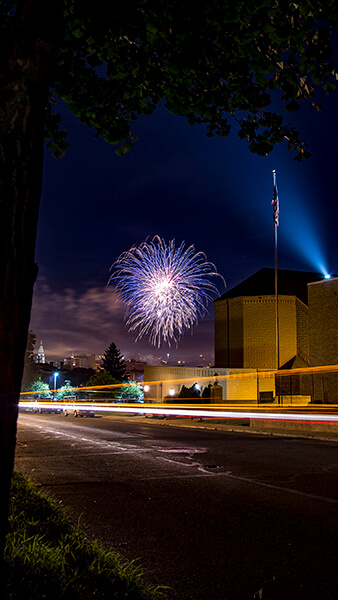June 26, 2018
Fireworks are fun for the eyes, dangerous for the ears, says Purdue audiology expert
 Purdue professor Anne Sommer says play it safe with hearing while enjoying fireworks displays. (Purdue University file photo)
Download image
Purdue professor Anne Sommer says play it safe with hearing while enjoying fireworks displays. (Purdue University file photo)
Download image
WEST LAFAYETTE, Ind. — Fireworks displays are an American summertime tradition, but while the spectacular colorful displays are visually pleasing, a Purdue University audiology instructor says the loud booms that accompany them are a problem for the ears.
“The volume level of the fireworks and duration of exposure to them are key when considering potential risk for hearing loss,” said Anne Sommer, an audiology clinical instructor in the College of Health and Human Sciences. “Noise induced hearing loss is 100 percent preventable with noise awareness education in addition to consistent and proper use of hearing protection.”
Fireworks displays range from around 120-170 decibels. A casual conversation is measured around 60 decibels.
The Occupational Safety and Health Administration considers 85 decibels as an action level where hearing protection must be made available, but is not mandatory, while 140 decibels is generally considered the threshold of pain. For each 5-decibel increase, OSHA recommends the exposure time be cut in half, meaning, even though a typical fireworks display may last 30 minutes or more, hearing damage can occur in less than 7 minutes.
“The World Health Organization recommends that adults not be exposed to more than 140 decibels of peak sound pressure,” Sommer said. “For children, the recommendation is 120 decibels. If a child reacts by crying or covering their ears while watching fireworks, it could be a sign that the loud sounds are causing pain.”
Sommer says the keys to safe fireworks viewing are keeping as much distance as possible from the sounds to lower the decibel level and consistent use of hearing protection, such as foam roll-down earplugs or earmuffs.
“When setting off personal fireworks in close range, double hearing protection is advised,” she said. “People should use properly inserted foam roll-down earplugs and earmuffs.”
Adults may experience muffled hearing or ringing in the ears after listening to loud sounds for too long. Sommer says if symptoms persist, they should talk to a medical professional and have a hearing assessment.
Writer: Tim Doty, 765-496-2571, doty2@purdue.edu
Source: Anne Sommer, 765-494-3789, sommera@purdue.edu
Note to Journalists: Anne Sommer is available for interviews. Please contact Sommer at 765-494-3789, sommera@purdue.edu, or Tim Doty 765-496-2571, doty2@purdue.edu, to schedule.

